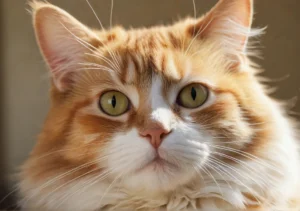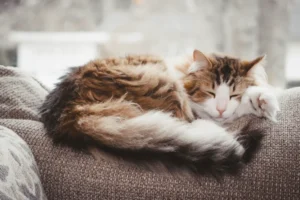Cats can be mysterious creatures, often displaying behaviors that leave their owners scratching their heads. One common question that many cat owners have is, “why does my cat huff when he’s mad?” This peculiar sound can be puzzling, but understanding the reasons behind it can help maintain a harmonious relationship with your feline friend.
When a cat huffs, it is often a sign of frustration or annoyance. These vocalizations are a way for cats to communicate their feelings, much like how humans might sigh or groan when they are feeling exasperated. By decoding the reasons behind your cat’s huffing, you can better address their needs and prevent further conflict.
Understanding Cat Communication
Cats are mysterious creatures with a unique way of expressing themselves. When your feline friend huffs, it’s a clear sign that something is amiss. Understanding cat communication is key to deciphering these signals they send our way.
Huffing is just one of the many vocalizations cats use to communicate their emotions. It’s often a sign of annoyance, frustration, or even aggression. In the feline world, huffing is like a warning signal, telling you to back off and give them some space.
In addition to huffing, cats may also hiss, meow, or purr to convey their feelings. Each of these sounds carries its own meaning, so pay attention to the context in which they occur to better understand what your cat is trying to tell you.
Remember, cats have their own language, and it’s up to us as pet parents to learn how to speak it. By tuning in to your cat’s vocalizations and body language, you can improve your bond and provide better care for your furry companion.
Triggers for Cat Huffing
Curious about what sets off your cat’s huffing episodes? There are several common triggers that can cause a cat to huff, and knowing them can help you address the root cause of your cat’s frustration.
Feeling threatened is a major trigger for huffing in cats. Whether it’s a new pet in the household, a loud noise, or a stranger approaching, cats may huff to show that they feel uncomfortable or scared.
Territorial disputes can also lead to huffing behavior. If your cat feels like their space is being invaded by another animal or even a person, they may huff as a way to defend their territory.
Lastly, discomfort or pain can cause a cat to huff. If your cat is experiencing physical discomfort, such as from an injury or illness, they may vocalize their distress through huffing.
By identifying the triggers for your cat’s huffing, you can take steps to address the underlying issues and create a more harmonious environment for your beloved pet.
Pro Tip: Providing your cat with plenty of enrichment, including toys, scratching posts, and hiding spots, can help reduce stress and decrease huffing behavior.
Techniques for Calming a Huffing Cat
When your cat starts huffing, it’s essential to remain calm and patient. One effective technique is to create a peaceful environment by removing any potential stressors like loud noises or sudden movements. Providing a cozy space for your cat to retreat to can also help them feel secure.
Building trust with your pet is crucial in calming them down. Spend quality time with your cat, offering gentle pets and verbal reassurance. Using treats and toys as positive reinforcements can also help redirect their focus and alleviate their frustration. Remember, patience is key when dealing with a huffing cat, so give them space if needed and avoid forcing interactions.
Additionally, incorporating calming activities like play sessions or grooming can help reduce your cat’s stress levels and prevent huffing episodes. By understanding your cat’s triggers and responding with patience and love, you can create a harmonious environment for both you and your feline friend.
The Difference Between Huffing and Other Sounds
When your cat huffs, it may sound similar to growling or purring, but it carries distinct meanings. Huffing typically indicates displeasure or frustration, often a warning sign that your cat is feeling agitated or upset. Growling, on the other hand, usually signifies aggression or territorial behavior, while purring indicates contentment or pleasure.
To differentiate between these sounds, pay attention to your cat’s body language. Huffing is often accompanied by dilated pupils, flattened ears, or a tense body posture. In contrast, purring is typically associated with a relaxed and happy cat. Understanding these cues can help you respond appropriately to your cat’s emotions and prevent misunderstandings.
By recognizing the nuances in your cat’s vocalizations and body language, you can deepen your bond with them and provide the care and support they need in moments of stress or frustration. This heightened awareness will help you communicate effectively with your feline companion and foster a trusting relationship based on mutual understanding.
Seeking Professional Help
If your cat’s huffing is accompanied by aggressive behavior or other concerning symptoms, it may be time to seek advice from a veterinarian or animal behaviorist. They can provide insights into why your cat is huffing and offer behavioral modification techniques to address the issue effectively. Remember, your cat’s well-being is a top priority, so don’t hesitate to reach out for professional assistance when needed.
Fun Facts About Cat Vocalizations
Cats are fascinating creatures with a wide range of vocalizations to communicate with us. Did you know that cats use different meows to convey various messages, such as asking for food, seeking attention, or expressing affection? They also purr not only when they’re content but also when they’re anxious or in pain. Understanding these vocal cues can help you better interpret your cat’s emotions and strengthen your bond with your furry friend.
Fun Fact List: 1. Chirping: Cats may chirp to imitate prey or when they’re excited. 2. Yowling: This loud, drawn-out sound is often used for mating calls or when a cat is in distress. 3. Growling: When cats feel threatened or territorial, they may growl to warn others to keep their distance. 4. Hissing: Cats hiss to show fear or aggression, signaling that they want to be left alone. 5. Trilling: A friendly sound, trilling is often used as a greeting or expression of happiness.
Remember, cats have their own unique ways of expressing themselves through vocalizations. Paying attention to these cues can help you better understand your feline companion and strengthen your bond with them.
Building a Strong Bond with Your Cat
Understanding why your cat huffs when he’s mad is a crucial step in building a strong bond with your feline friend. Cats use a variety of vocalizations and body language to communicate their emotions, and huffing is one way they express displeasure or annoyance. By paying attention to these signals, you can learn more about what triggers your cat’s anger and find ways to address it.
When your cat huffs, it’s essential to respect his boundaries and give him space. Avoid pushing or forcing interaction when he’s upset, as this can lead to further stress and potential aggression. Instead, try to identify the source of his frustration and find ways to alleviate it. This could involve providing more playtime, creating a peaceful environment, or addressing any potential triggers that may be causing him distress.
By responding to your cat’s emotions with empathy and understanding, you show him that you respect his feelings and care about his well-being. This can help strengthen the bond between you and your cat, creating a more harmonious and fulfilling relationship.
Remember, building a strong bond with your cat is a two-way street. By taking the time to understand and respond to his emotions, you can create a deeper connection based on trust, respect, and love. This will not only benefit your cat but also enhance your own happiness and fulfillment as a pet owner.
Additional Unique Insight:
- Consider implementing positive reinforcement training techniques when addressing your cat’s behavioral issues. By rewarding good behavior with treats or affection, you can encourage positive habits and strengthen your bond even further.
For further reading on cat behavior and communication, check out this helpful resource.
Alex, a passionate animal lover, has experience in training and understanding animal behavior. As a proud pet parent to two dogs and three cats, he founded AnimalReport.net to share insights from animal experts and expand his knowledge of the animal kingdom.




